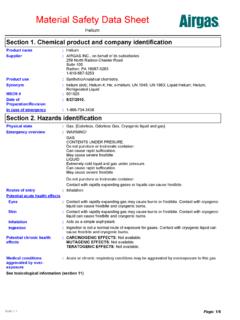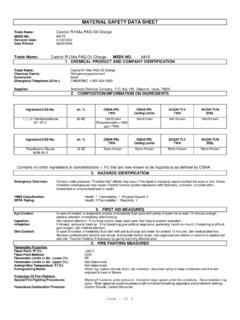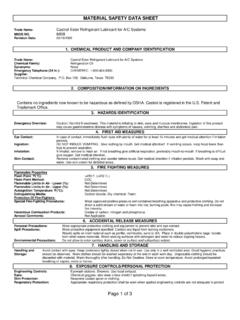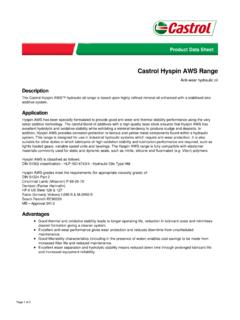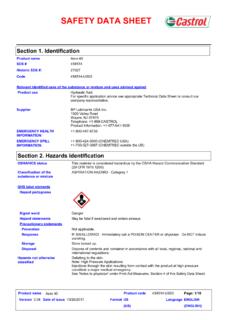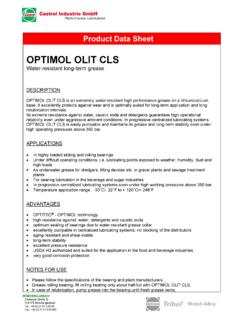Transcription of Material Safety Data Sheet - Lakeland University
1 Material Safety data and company identificationProduct nameCastrol GTX 10W-30 msds #459835 Product useEngine specific application advice see appropriate Technical data Sheet or consult our US13 US81 CA01 ManufacturerBP Lubricants USA Valley RoadWayne, NJ 07470 Telephone: (973) 633-2200 Telecopier: (973) 633-7475 EMERGENCY HEALTHINFORMATION:1 (800) 447-8735 Outside the US: +1 703-527-3887 (CHEMTREC)EMERGENCY SPILLINFORMATION:1 (800) 424-9300 CHEMTREC (USA)OTHER PRODUCTINFORMATION1 (866) 4 BP - msds (866-427-6737 Toll Free - North America)email: identificationPhysical overviewCAUTION !MAY CAUSE RESPIRATORY TRACT, EYE AND SKIN or repeated contact can defat the skin and lead to irritation and/or dermatitis. Inaccordance with good industrial hygiene and Safety work practices, airborne exposures should becontrolled to the lowest extent practicable.
2 Avoid contact with eyes, skin and clothing. Use onlywith adequate ventilation. Keep container tightly closed and sealed until ready for use. Washthoroughly after contact. Eye contact. Inhalation. of entryPotential health effectsEyesMay cause eye cause skin irritation. Prolonged or repeated contact can defat the skin and lead to irritationand/or cause respiratory tract may cause gastrointestinal irritation and toxicological information (section 11) of issue08/04 : 1/6 castrol GTX 10W-30 ENGLISH.(ENGLISH)Product nameProduct codeVersion2 FormatLanguageUS459835-US12 US13 US81CA01(US) on ingredientsIngredient nameCAS #%Base oil - highly refinedVaries85 - 90 Zinc alkyl dithiophosphate68649-42-31 - aid measuresEye contactIn case of contact, immediately flush eyes with plenty of water for at least 15 minutes.
3 Get medicalattention if symptoms contactImmediately wash exposed skin with soap and water. Remove contaminated clothing and clothing before reuse. Clean shoes thoroughly before reuse. Get medical attention ifsymptoms inhaled, remove to fresh air. Get medical attention if symptoms not induce vomiting unless directed to do so by medical personnel. Never give anything bymouth to an unconscious person. If potentially dangerous quantities of this Material have beenswallowed, call a physician immediately. Get medical attention if symptoms measuresNon-explosive in the presence of the following materials or conditions: open flames, sparks andstatic discharge, heat and shocks and mechanical fire/explosionhazardsPromptly isolate the scene by removing all persons from the vicinity of the incident if there is a action shall be taken involving any personal risk or without suitable clothing (fire)Fire-fighters should wear appropriate protective equipment and self-contained breathing apparatus(SCBA) with a full face-piece operated in positive pressure proceduresHazardous combustionproductsCombustion products may include the following.
4 Phosphorus oxidesmetal oxide/oxidescarbon oxides (CO, CO2) (carbon monoxide, carbon dioxide)In a fire or if heated, a pressure increase will occur and the container may hazardsFlash pointClosed cup: >200 C (>392 F) [Pensky-Martens.]Extinguishing mediaSuitableUse an extinguishing agent suitable for the surrounding not use water release measuresNo action shall be taken involving any personal risk or without suitable training. Keep unnecessaryand unprotected personnel from entering. Do not touch or walk through spilled Material . Inaccordance with good industrial hygiene and Safety work practices, airborne exposures should becontrolled to the lowest extent practicable. Provide adequate ventilation. Wear appropriaterespirator when ventilation is inadequate. Put on appropriate personal protective equipment (seesection 8).
5 Stop leak if without risk. Move containers from spill area. Approach release from upwind. Prevententry into sewers, water courses, basements or confined areas. Wash spillages into an effluenttreatment plant or proceed as follows. Contain and collect spillage with non-combustible,absorbent Material sand, earth, vermiculite or diatomaceous earth and place in container fordisposal according to local regulations (see section 13). Dispose of via a licensed waste disposalcontractor. Contaminated absorbent Material may pose the same hazard as the spilled : see section 1 for emergency contact information and section 13 for waste dispersal of spilled Material and runoff and contact with soil, waterways, drains and the relevant authorities if the product has caused environmental pollution (sewers,waterways, soil or air).
6 Personal precautionsLarge spillMethods for cleaning upDate of issue08/04 : 2/6 castrol GTX 10W-30 ENGLISH.(ENGLISH)Product nameProduct codeVersion2 FormatLanguageUS459835-US12 US13 US81CA01(US)Stop leak if without risk. Move containers from spill area. Dilute with water and mop up if water-soluble or absorb with an inert dry Material and place in an appropriate waste disposal of via a licensed waste disposal and storageHandlingPut on appropriate personal protective equipment (see section 8). Workers should wash handsand face before eating, drinking and smoking. Do not breathe vapor or mist. Do not ingest. Avoidcontact with eyes, skin and clothing. Use only with adequate ventilation. Wear appropriaterespirator when ventilation is in accordance with local regulations. Store away from direct sunlight in a dry, cool and well-ventilated area, away from incompatible materials (see section 10).
7 Keep container tightly closedand sealed until ready for use. Containers that have been opened must be carefully resealed andkept upright to prevent leakage. Do not store in unlabeled containers. Use appropriatecontainment to avoid environmental compounds in this Material may decompose when heated to release hydrogen sulfide gaswhich may accumulate to potentially lethal concentrations in enclosed air spaces. Vaporconcentrations of hydrogen sulfide above 50 ppm, or prolonged exposure at lower concentrations,may saturate human odor perceptions so that the smell of gas may not be apparent. Exposure toconcentrations of hydrogen sulfide vapor above 500 ppm may cause rapid death. Do not rely onthe sense of smell to detect hydrogen controls/personal protectionOccupational exposure limitsBase oil - highly refinedACGIH (United States).
8 TWA: 5 mg/m 8 hour(s). Form: Mineral oil, mistOSHA (United States).TWA: 5 mg/m 8 hour(s). Form: Mineral oil, mistIngredient nameOccupational exposure limitsSome states may enforce more stringent exposure specific OELs for certain components may be shown in this section, other components may be present in any mist, vapor ordust produced. Therefore, the specific OELs may not be applicable to the product as a whole and are provided for guidance MeasuresUse only with adequate ventilation. If user operations generate dust, fumes, gas, vapor or mist,use process enclosures, local exhaust ventilation or other engineering controls to keep workerexposure to airborne contaminants below any recommended or statutory measuresWash hands, forearms and face thoroughly after handling chemical products, before eating,smoking and using the lavatory and at the end of the working period.
9 Appropriate techniquesshould be used to remove potentially contaminated clothing. Wash contaminated clothing protectionEyesAvoid contact with eyes. Safety glasses with side shields or chemical and bodyAvoid contact with skin and clothing. Wear suitable protective adequate ventilation. In accordance with good industrial hygiene and Safety work practices,airborne exposures should be controlled to the lowest extent correct choice of protective gloves depends upon the chemicals being handled, the conditionsof work and use, and the condition of the gloves (even the best chemically resistant glove willbreak down after repeated chemical exposures). Most gloves provide only a short time ofprotection before they must be discarded and replaced. Because specific work environments andmaterial handling practices vary, Safety procedures should be developed for each intendedapplication.
10 Gloves should therefore be chosen in consultation with the supplier/manufacturer andwith a full assessment of the working your supervisor or Standard Operating Procedure ( ) for special handling of issue08/04 : 3/6 castrol GTX 10W-30 ENGLISH.(ENGLISH)Product nameProduct codeVersion2 FormatLanguageUS459835-US12 US13 US81CA01(US)Physical and chemical : 71 to 75 mm2/s (71 to 75 cSt) at 40 CKinematic: mm2/s ( cSt) at 100 CFlash pointClosed cup: >200 C (>392 F) [Pensky-Martens.]Solubilityinsoluble in and reactivityThe product is or incompatible with the following materials: oxidizing all possible sources of ignition (spark or flame).Stability and reactivityConditions to avoidIncompatibility withvarious substancesHazardous decompositionproductsUnder normal conditions of storage and use, hazardous polymerization will not polymerizationHydrogen Sulfide (H2S)Possibility of hazardousreactionsUnder normal conditions of storage and use, hazardous reactions will not informationUSED ENGINE OILSC ombustion products resulting from the operation of internal combustion engines contaminateengine oils during use.



